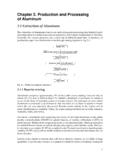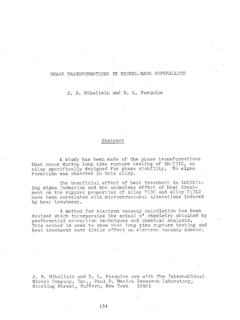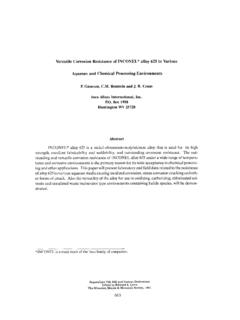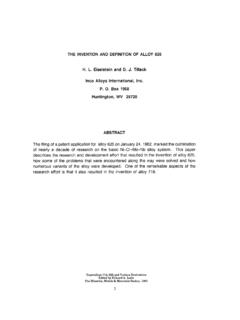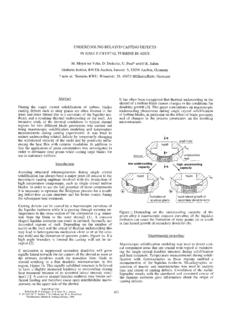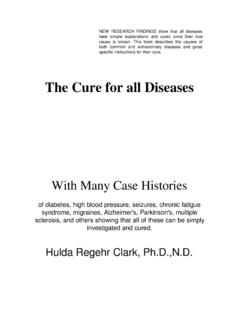Transcription of P/M Alloy 10 - A 700ºC Capable Nickel-Based …
1 P/M Alloy 10 A 700 C Capable Nickel-Based SUPERALLOY FOR TURBINE DISK APPLICATIONS D. Rice1, P. Kantzos1, B. Hann1, J. Neumann1, R. Helmink2 1 Honeywell Aerospace 111 S. 34th St., Phoenix, Arizona, 85034, USA 2 Rolls-Royce North American Technologies Inc. PO Box 7162 (X12), Indianapolis, IN 46207, USA Keywords: P/M superalloys, microstructure, Alloy 10, heat treatment Abstract The Versatile Affordable Advanced Turbine Engine (VAATE) program has been supporting the development of Alloy 10, a gas-atomized powder metal (PM) superalloy. Funding for the program was provided by Air Force Research Laboratory (AFRL).
2 Honeywell International, Rolls Royce Allison Advanced Development Company (AADC), and Williams International have been jointly developing Alloy 10 for small and large gas turbine engine applications. Alloy 10 is a demonstrated industry leader in high temperature creep resistance, and has been produced using production-scale equipment for high pressure turbine disk applications. To address cost issues, the VAATE Alloy 10 project evaluated the relative differences between material densified by hot isostatic pressing (as-HIP) and material produced by extrusion followed by isothermal forging.
3 The program was completed as a series of four tasks: (i) chemistry optimization, (ii) as-HIP compaction, (iii) HIP compaction plus isothermal forging for small engine applications, and (iv) extrusion plus isothermal forging for large engine applications. This report provides the status of the program, microstructures typical of the various Alloy 10 product forms, and a summary of initial mechanical properties data. Introduction In the design and optimization of a turbine disk Alloy , attempts are made to balance the tensile and low-cycle fatigue (LCF) requirements of the disk bore with the creep rupture and dwell crack growth resistance of the disk rim.
4 When developing the processing route for Alloy 10, additional attention was given to its notch sensitivity in an effort to enable an increased temperature exposure of the blade attachment slot. To achieve a balance of chemistry and mechanical properties, industry leaders have developed gas atomization processes, billet extrusion and isothermal forging capabilities, and specialized thermal mechanical processing Strength-dependent properties are typically enhanced by the solution heat treating forgings below the gamma prime solvus ( , subsolvus) followed by a rapid cooling scheme.
5 This maintains a fine grain size while solutioning a sizable fraction of the .2 However, operating the disk rim at 700 C will require a microstructure optimized for time dependent properties, requiring a coarser grain size resulting from solution heat treating above the solvus ( , supersolvus). Another option is to fabricate dual microstructure forgings, characterized by a fine grain bore and a coarse grain rim, such that the interface is located in a relatively benign region of the machined disk.
6 Alloy 10 is an argon gas-atomized powder Nickel-Based ,4 The Alloy is vacuum induction melted (VIM) prior to argon gas atomization. The powder is then sieved to -270 mesh (-53 micron) and loaded into mild or stainless steel containers and subsolvus HIP compacted. In the VAATE Alloy 10 program, material was characterized in two product forms (i) extruded billet plus isothermally forged disks (E+I) and (ii) as-HIP compacted right cylinders. The industry standard practice when fabricating non-contained high pressure turbine disks for propulsion applications is billet extrusion plus isothermal forging.
7 Honeywell has an interest in as-HIP powder for turbine disk materials because of the significant cost savings and reduced lead times relative to isothermal forgings combined with a promising portfolio of mechanical properties. Applications where as-HIP powder metal turbine disks are viable include auxiliary power units. The first task of the VAATE Alloy 10 program required optimization of the materials chemistry for sustained operation at 700 C. To address the tendency of the Alloy to precipitate embrittling TCP phases, sub-scale as-HIP compacts of the Alloy with chromium content varied from % wt.
8 To % wt. were fabricated, supersolvus solution heat treated, gas fan cooled, and aged at 760 C for 16 hrs. Specimens machined from the sub-scale as-HIP compacts were submitted to notched/smooth combination creep rupture testing. The failed specimens were submitted for scanning electron microscopy (SEM) fractography and the presence of TCP phases and time to failure were correlated with % wt. Cr. This information was used to down-select the final chemistry of VAATE Alloy 10 to be used in the remainder of the program.
9 Materials evaluated in this program were processed to provide both subsolvus fine-grained disks and supersolvus coarse-grained disks. Subsolvus as-HIP disks and isothermally forged disks were salt bath solution heat treated at solvus minus 22 C, quenched into a salt bath, then stabilized and aged. Supersolvus as-HIP disks and isothermally forged disks were salt bath heat treated at plus 22 C and quenched in a salt bath, then stabilized and aged. Salt bath heat treating was selected as the thermal processing route to enable rapid quenching while attempting to mitigate the risks associated with quench cracking.
10 A rapid quench was desired to maximize the tensile properties of the material. Material was then stabilized at 871 C for 4 hrs to mitigate the risk of notch sensitivity in broach blade attachment slot5,6 The disks were then aged at 760 C for 16 hrs. The intent of the supersolvus thermal processing route selected for Alloy 10 was to enable a disk rim operating temperature of 700 C. At such a high operating temperature, dwell fatigue crack growth life is a significant concern for all Nickel-Based superalloys, including 3rd generation materials like Alloy 10.

